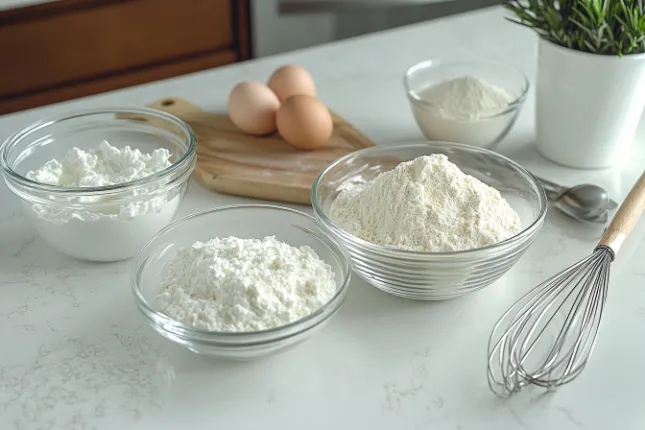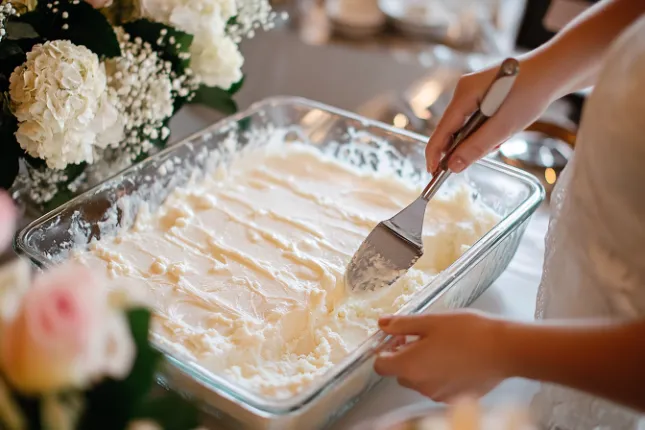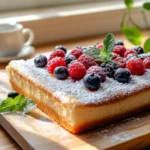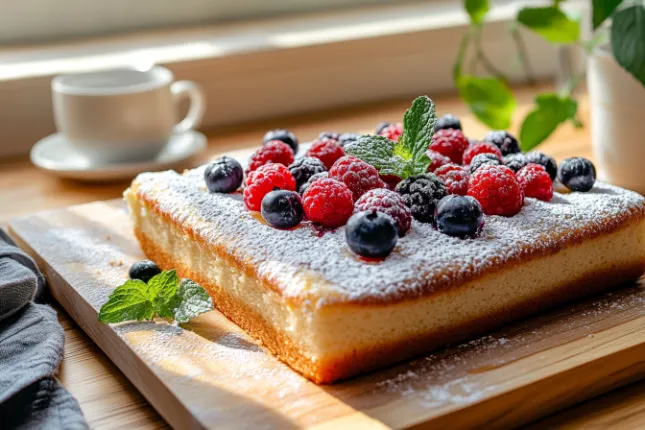Baking is one of life’s simple joys. Whether you’re whipping up something for a party or just satisfying a craving, sheet cakes always deliver. They’re easy, versatile, and loved by all—especially when they have a little something extra to set them apart. That’s where kefir comes in. This tangy, probiotic-rich ingredient adds a whole new depth of flavor to your baked goods, and in today’s article, we’re diving headfirst into the kefir sheet cake recipe card.
Why kefir, you ask? Well, it’s not just delicious—it’s also incredibly nutritious, full of probiotics and nutrients that support gut health. This cake combines that wholesome goodness with the rich, fluffy texture of a classic sheet cake. The result? A dessert that’s as indulgent as it is good for you.
Moreover, this recipe is foolproof, making it perfect for beginners and experienced bakers alike. Plus, it’s versatile—you can dress it up for special occasions or keep it simple for a casual treat. For another delicious dish to pair with your baking, try our Zucchini Beef Fry Recipe.
Now, let’s roll up our sleeves and dive into the fascinating history and origin of this tangy twist on a classic cake!
History and Origin
The Ancient Roots of Kefir
Kefir isn’t just another trendy ingredient—it’s been around for centuries. Originating in the Caucasus Mountains, kefir was traditionally made by fermenting milk in animal skin pouches. Families passed down their kefir grains from generation to generation, treating them as prized possessions.
This fermented milk drink wasn’t just a tasty beverage—it was also believed to have medicinal properties, promoting digestion and overall health. Over time, kefir spread across Europe and the Middle East, eventually making its way into kitchens worldwide. Today, it’s a staple in both drinks and dishes, thanks to its tangy flavor and versatile nature.
Sheet Cakes: An American Classic
Sheet cakes, on the other hand, have a more recent history. This dessert became wildly popular in the United States during the 20th century as a quick and easy way to feed a crowd. With their minimal prep and endless topping options, sheet cakes quickly found a home at birthday parties, potlucks, and family dinners.
Combining the ancient tradition of kefir with the modern charm of sheet cakes gives us the perfect fusion of flavor, texture, and history. This recipe showcases how old-world ingredients can elevate everyday baking into something extraordinary.
Cultural Significance and Baking Evolution
What makes the kefir sheet cake recipe card special is how it bridges cultures and time. It’s a testament to how food evolves, blending ancient fermentation techniques with modern baking. Plus, kefir’s probiotic properties make this cake more than just a dessert—it’s a treat with benefits.
Want to explore more ideas on how kefir transforms baking? Discover creative inspirations for kefir-based dishes and expand your culinary repertoire!
Ingredients and Equipment
Ingredients for the Kefir Sheet Cake
This cake is all about simplicity, so you won’t need anything fancy. Here’s the complete list of ingredients, along with substitutions to suit various dietary preferences:
| Ingredient | Quantity | Substitutions |
|---|---|---|
| All-purpose flour | 2 cups | Gluten-free flour blend (1:1 ratio) |
| Granulated sugar | 1 cup | Coconut sugar or honey |
| Baking powder | 1 tsp | Double amount of baking soda |
| Baking soda | 1 tsp | Increase baking powder to 2 tsp |
| Salt | 1/2 tsp | Sea salt or kosher salt |
| Large eggs | 2 | Flax eggs for a vegan option |
| Plain kefir | 1 cup | Buttermilk or plain yogurt |
| Vegetable oil | 1/2 cup | Melted coconut oil or olive oil |
| Vanilla extract | 1 tsp | Almond or lemon extract for variation |
Essential Equipment
To make the kefir sheet cake recipe card, you’ll need the following tools:
- 9×13-inch sheet pan: Ensures even baking and a perfect texture.
- Mixing bowls: One for wet ingredients and one for dry ingredients.
- Whisk and spatula: Helps combine the ingredients without overmixing.
- Measuring cups and spoons: Baking is all about precision!
- Cooling rack: Prevents overcooking by allowing the cake to cool evenly.

For more insights into choosing the right tools for baking, take a look at this baking equipment guide.
Creating the perfect kefir sheet cake recipe card requires just a few simple steps, but the key is precision and care. Let’s walk through the process together, from mixing the batter to enjoying the final slice.
How to make Kefir Sheet Cake
Step 1: Prepping the Ingredients
Before diving into the mixing process, preparation is essential. Start by gathering all your ingredients and tools listed in the previous section.
- Measure Out Ingredients
- Accurately measure each ingredient. For instance, spoon your flour into the measuring cup and level it off with a knife to avoid adding too much.
- Crack the eggs into a small bowl to check for shells before adding them to the mix.
- Preheat the Oven
- Set your oven to 350°F (175°C) and grease a 9×13-inch sheet pan. Alternatively, you can line the pan with parchment paper for easier removal later.
- Prepare the Kefir
- If your kefir is chilled, let it come to room temperature. This ensures it mixes well with the other ingredients and prevents clumping.
Helpful Tip: Use a large mixing bowl for the dry ingredients and a separate medium bowl for the wet ones. This makes combining everything a breeze!
Step 2: Mixing the Batter
This is where the magic begins!
- Combine Dry Ingredients
- In a large bowl, whisk together the flour, sugar, baking powder, baking soda, and salt. Mixing these first helps evenly distribute the leavening agents, so your cake rises perfectly.
- Blend Wet Ingredients
- In a separate bowl, mix the kefir, eggs, vegetable oil, and vanilla extract. Whisk until smooth and well-blended.
- Incorporate Wet into Dry
- Gradually pour the wet mixture into the dry ingredients, stirring gently with a spatula. Mix until the batter is just combined. Be careful not to overmix—overmixing can lead to a dense cake.
Pro Tip: For an extra tangy kick, add a teaspoon of lemon zest to the batter.
Step 3: Baking the Cake
Once your batter is ready, it’s time to bake!
- Pour Batter into the Pan
- Evenly spread the batter into your prepared sheet pan. Use a spatula to smooth the top for a uniform appearance.
- Bake Until Perfect
- Place the pan in the preheated oven and bake for 25–30 minutes. Start checking for doneness at the 25-minute mark. Insert a toothpick into the center of the cake—if it comes out clean, it’s ready!
- Cool on a Rack
- Remove the cake from the oven and let it cool in the pan for about 10 minutes. Then, transfer it to a wire rack to cool completely.
Helpful Tip: If the edges of your cake brown too quickly, tent the pan with aluminum foil during the last 5 minutes of baking.
Step 4: Decorating the Cake
Here’s where you can let your creativity shine.
- Frosting Options
- Classic Buttercream: Whip up a simple buttercream frosting by beating butter, powdered sugar, and vanilla extract until fluffy.
- Tangy Glaze: Mix powdered sugar with a splash of kefir for a tangy glaze that complements the cake’s flavor.
- Toppings
- Sprinkle crushed nuts, shredded coconut, or fresh berries over the frosting. These toppings add texture and visual appeal.
Pro Tip: Drizzle some honey over the frosting for a touch of natural sweetness.
Step 5: Slicing and Serving
Now comes the best part—eating your masterpiece!
- Slice the Cake
- Use a sharp knife to cut the cake into even squares or rectangles. Wipe the blade clean between cuts for neat slices.
- Serve with Style
- Arrange the slices on a decorative plate. Garnish each piece with a sprig of mint or a dusting of powdered sugar for an elegant touch.
Bonus Tips for Perfect Results
- Avoid Overmixing
- Stir gently and stop as soon as the ingredients are combined. Overmixing can activate the gluten in the flour, leading to a tough cake.
- Adjust for Altitude
- If you’re baking at a high altitude, slightly reduce the baking soda and increase the baking temperature by 15°F.
- Store the Cake Properly
- Wrap leftovers in plastic wrap and store at room temperature for up to 2 days. For longer storage, refrigerate the cake in an airtight container.
Why This Recipe Works
The combination of kefir and baking soda is a game-changer in baking. Kefir’s acidity reacts with the baking soda to create air bubbles, resulting in a cake that’s light, fluffy, and oh-so-moist. Plus, its tangy flavor adds a unique twist that sets this cake apart from traditional sheet cakes.
With these step-by-step instructions, your kefir sheet cake recipe card is guaranteed to turn out perfectly every time. Ready to bake? Let’s do this!

Tips for Perfecting the Kefir Sheet Cake Recipe Card
Common Challenges and How to Overcome Them
Even the most experienced bakers can encounter hiccups. But don’t worry—here’s how to tackle some of the most common challenges when making your kefir sheet cake recipe card.
- Cake Turned Out Dense
- Cause: Overmixing the batter activates the gluten, resulting in a dense cake.
- Solution: Stir just until the ingredients are combined. The batter doesn’t need to be perfectly smooth.
- Cake Didn’t Rise Evenly
- Cause: Uneven heat in the oven or outdated leavening agents.
- Solution: Always check your baking soda and baking powder for freshness. Additionally, preheat your oven fully and rotate the pan halfway through baking.
- Dry or Crumbly Texture
- Cause: Overbaking is often the culprit.
- Solution: Keep an eye on the cake as it nears the end of its baking time. Test with a toothpick and remove the cake as soon as it comes out clean.
Pro Tips for Exceptional Results
- Room Temperature Ingredients
- Bring the kefir, eggs, and any refrigerated ingredients to room temperature. This ensures they mix smoothly, creating a better texture.
- Use High-Quality Kefir
- Opt for plain, unsweetened kefir with no added flavors. If possible, homemade kefir offers unparalleled freshness and tang.
- Grease and Line the Pan
- To make sure your cake releases effortlessly, grease the pan generously or line it with parchment paper.
- Customize the Flavor
- Add a dash of cinnamon or nutmeg to the batter for a warm, spiced twist. You could even mix in chocolate chips or dried fruit for variety.
Bonus Tip: For a golden-brown finish, lightly sprinkle sugar over the batter before baking.
Looking for more creative serving ideas? Pair this cake with our refreshing Carrot and Chickpea Salad with Parsley and Lemon for a perfect balance of sweet and savory on your table!
Serving and Garnishing Ideas
Once your kefir sheet cake recipe card masterpiece is baked to perfection, it’s time to focus on presentation and pairing.
Creative Presentation Tips
- Layered Elegance
- Slice the cake into neat squares and stack two layers with frosting in between for a mini-cake effect.
- Dusting with Style
- Sprinkle powdered sugar or cocoa powder over the top using a stencil for a decorative pattern.
- Add Color and Freshness
- Garnish with fresh fruits like berries or edible flowers. They add both visual appeal and a burst of freshness to every bite.
Pro Tip: Plate the cake on a simple white dish to let the colors of the garnishes pop!
Perfect Pairings for Your Cake
Pairing the cake with the right sides or beverages elevates the experience.
- Beverages
- Serve with a hot cup of chai tea or coffee for a cozy treat. If you prefer cold drinks, a tall glass of iced tea or lemonade works wonders.
- Side Treats
- Add a scoop of vanilla ice cream or a dollop of whipped cream. The creamy texture complements the cake’s tangy flavor.
- Savory Balances
- Consider serving alongside a cheese platter with tangy cheeses like brie or goat cheese for a unique dessert spread.
Bringing It All Together
With these serving and garnishing ideas, your kefir sheet cake recipe card will look as good as it tastes. Whether you’re hosting a fancy gathering or enjoying a quiet evening at home, this cake is versatile enough to fit any occasion.
Additional Insights and Dietary Considerations
Healthier Alternatives and Variations
Creating a versatile kefir sheet cake recipe card doesn’t just mean sticking to the basics. There are plenty of ways to adapt this recipe for various dietary needs or healthier lifestyles.
- Gluten-Free Option
- Swap out the all-purpose flour for a high-quality gluten-free baking mix. Ensure it contains xanthan gum for better structure.
- Low-Sugar Variation
- Replace half the sugar with a natural sweetener like stevia or monk fruit. Alternatively, use coconut sugar for a deeper, caramel-like flavor that’s less processed.
- Dairy-Free Alternative
- Substitute kefir with a plant-based alternative like coconut kefir or oat-based yogurt. Use almond or soy milk as a liquid adjustment, if needed.
- Egg-Free Version
- Replace each egg with a flaxseed or chia seed substitute (1 tablespoon ground seeds mixed with 3 tablespoons of water per egg).
- Add More Fiber
- Incorporate oat flour or almond meal into the batter to boost the fiber content. You can also mix in grated zucchini or carrots for added moisture and nutrition.
Pro Tip: For a nutty twist, sprinkle slivered almonds or chopped walnuts on top of the batter before baking.
Pairing Beverages for Enhanced Enjoyment
Pairing beverages with your kefir sheet cake recipe card can elevate its flavors and provide a well-rounded experience.
- Hot Beverages:
- A cup of green tea or herbal chamomile perfectly balances the cake’s tangy sweetness.
- For coffee lovers, a lightly sweetened latte or cappuccino is a comforting match.
- Cold Drinks:
- Serve with an iced matcha latte or a sparkling water infused with lemon and mint for a refreshing contrast.
- For kids, a cold glass of almond chocolate milk or fresh orange juice works wonderfully.
- Dessert Wines:
- If you enjoy a wine pairing, a sweet Moscato or a late-harvest Riesling complements the tangy notes of kefir.
Quick Pairing Tip: Try serving the cake with this carrot and chickpea salad with parsley and lemon for a creative combination of savory and sweet flavors.
Storing and Reheating the Kefir Sheet Cake Recipe Card
To fully enjoy your kefir sheet cake recipe card, knowing how to store and reheat it properly is essential.
Storing Your Cake
- Room Temperature:
- Store the cake in an airtight container at room temperature for up to 2 days. Avoid exposing it to direct sunlight or excessive humidity.
- Refrigerator:
- For extended freshness, wrap the cake tightly in plastic wrap and place it in the refrigerator. It can last up to 5 days this way.
- Freezing:
- Slice the cake into portions, wrap each slice in parchment paper, and store them in a freezer-safe container or bag. Frozen cake can be kept for up to 3 months.
Reheating Tips
- Microwave:
- Place a slice on a microwave-safe plate and heat for 15-20 seconds. Add a damp paper towel over the slice to retain moisture.
- Oven:
- Reheat the cake in an oven preheated to 300°F for 5-7 minutes. Cover it loosely with aluminum foil to prevent drying.
- Room Temperature:
- If time allows, let the cake thaw naturally at room temperature for a couple of hours before serving.
Storage Pro Tip: If you’ve added frosting, avoid microwaving it as it can melt unevenly. Instead, enjoy the cake at room temperature or reheat the unfrosted portion only.
By considering these tips and variations, you can ensure that your kefir sheet cake recipe card stays fresh and fits any occasion or dietary need. Whether you’re serving it fresh or pulling it out of the freezer for a quick treat, this cake is as adaptable as it is delicious!
Ready to move on to Part 8 and Part 9, or tweak anything else?
Frequently Asked Questions About the Kefir Sheet Cake Recipe Card
What Does Kefir Do in Baking?
Kefir plays a crucial role in baking, especially in recipes like the kefir sheet cake recipe card. Its tangy flavor adds depth, while its acidity reacts with baking soda to create a light, fluffy texture. Moreover, kefir’s probiotics and nutrients bring a healthy twist to your baked goods. For example, if you’re looking to replace buttermilk or yogurt in a recipe, kefir works as a perfect substitute, offering similar moisture and consistency.
Can I Use Kefir Instead of Buttermilk in Cake?
Absolutely! Kefir can seamlessly replace buttermilk in cake recipes. Since both have a similar tangy flavor and consistency, they’re interchangeable without any need for adjustments. For example, if a recipe calls for 1 cup of buttermilk, use an equal amount of kefir instead. Consequently, your cake will retain its moistness and achieve a lovely tender crumb.
Can I Use Kefir Instead of Milk in Muffins?
Yes, kefir is an excellent alternative to milk in muffins. However, because kefir is thicker than milk, you might need to dilute it slightly with water or an unsweetened plant-based milk to match the required consistency. For instance, combine 3/4 cup of kefir with 1/4 cup of water to replace 1 cup of milk in your muffin batter. This adjustment maintains the balance of flavors while adding a subtle tang.
Can I Cook with Kefir Milk?
Certainly! Kefir is highly versatile and works well in both sweet and savory dishes. In baking, it adds richness and flavor to cakes, pancakes, and bread. For savory recipes, use kefir in marinades, soups, or creamy salad dressings. Just remember to avoid boiling kefir directly, as high heat can kill its probiotics. For baking, this isn’t an issue, but for other uses, gently warming it is a better choice.
Pro Tip: Discover creative ways to use kefir in your cooking with dishes like our Zucchini Beef Fry Recipe. It’s a delicious and versatile choice for your meals!
Conclusion and Final Thoughts
The kefir sheet cake recipe card is more than just a dessert—it’s a fusion of tradition, flavor, and nutrition. From its light, fluffy texture to its tangy, rich flavor, this cake brings something special to the table. Plus, its versatility allows you to tweak it to suit your dietary preferences, whether you need a gluten-free option, a dairy-free alternative, or a lower-sugar version.
For example, using kefir as the star ingredient not only enhances the cake’s taste but also provides health benefits that make it guilt-free. Whether you’re serving it at a party or enjoying it as an everyday treat, this recipe is guaranteed to impress.
Encouraging Feedback and Exploration
Now that you’re equipped with all the tips, tricks, and insights for mastering the kefir sheet cake recipe card, it’s time to get baking! Try the recipe, share it with friends, and let us know your thoughts. We’d love to hear about your creative twists and flavor experiments.
Additionally, don’t stop here—explore more delicious recipes and ideas on our site. For inspiration, try our Garlic Butter Steak Bites and Mash Recipe for a flavorful and hearty pairing!
Final Pro Tip:
Save this recipe card for future use, and you’ll have the perfect go-to dessert for any occasion!
Table of Contents

Kefir Sheet Cake Recipe Card: A Tangy Twist on a Classic
- Total Time: 45 minutes
- Yield: 12 servings 1x
- Diet: Vegetarian
Description
Discover how to bake the perfect kefir sheet cake! This cake is moist, flavorful, and has a delightful tanginess that sets it apart. Ideal for family gatherings, casual treats, or celebrations, this simple yet unique recipe is packed with probiotics and a whole lot of flavor.
Ingredients
- 2 cups all-purpose flour (substitute with gluten-free flour if needed)
- 1 cup granulated sugar (or coconut sugar for a healthier twist)
- 1 tsp baking powder
- 1 tsp baking soda
- 1/2 tsp salt
- 2 large eggs (or flax eggs for a vegan option)
- 1 cup plain kefir (can substitute with buttermilk or plain yogurt)
- 1/2 cup vegetable oil (or melted coconut oil)
- 1 tsp vanilla extract
Instructions
- Preheat your oven to 350°F (175°C) and prepare a 9×13-inch sheet pan by greasing it or lining it with parchment paper.
- Combine dry ingredients: In a large mixing bowl, whisk together the flour, sugar, baking powder, baking soda, and salt.
- Mix wet ingredients: In another bowl, beat the eggs until frothy. Add kefir, vegetable oil, and vanilla extract, and whisk until smooth.
- Blend wet and dry: Gradually pour the wet mixture into the dry ingredients. Use a spatula to gently fold until no streaks of flour remain. Be careful not to overmix.
- Pour batter into the prepared pan and spread it evenly.
- Bake in the preheated oven for 25–30 minutes, or until a toothpick inserted into the center comes out clean.
- Cool the cake: Let the cake cool in the pan for 10 minutes before transferring it to a wire rack to cool completely.
- Decorate and serve: Add your choice of frosting, glaze, or powdered sugar before serving.
Notes
- For a tangier flavor, use lemon kefir instead of plain kefir.
- Make it gluten-free by swapping the all-purpose flour with a gluten-free flour blend.
- Store leftovers in an airtight container at room temperature for up to 2 days or refrigerate for up to 1 week.
- Freeze slices individually for longer storage—just thaw and reheat before serving.
- Prep Time: 15 minutes
- Cook Time: 30 minutes
- Category: Dessert
- Method: Baking
- Cuisine: American
Nutrition
- Serving Size: 1 slice (1/12th of the cake)
- Calories: ~220 kcal
- Sugar: ~16g
- Sodium: ~180mg
- Fat: ~10g
- Saturated Fat: ~2g
- Unsaturated Fat: ~7g
- Trans Fat: 0g
- Carbohydrates: ~30g
- Fiber: ~1g
- Protein: ~4g
- Cholesterol: ~35mg
Keywords: kefir sheet cake recipe card, kefir cake, tangy sheet cake, kefir dessert, probiotic cake, sheet cake recipe




